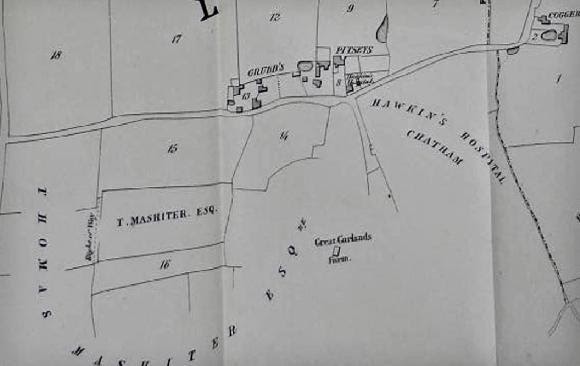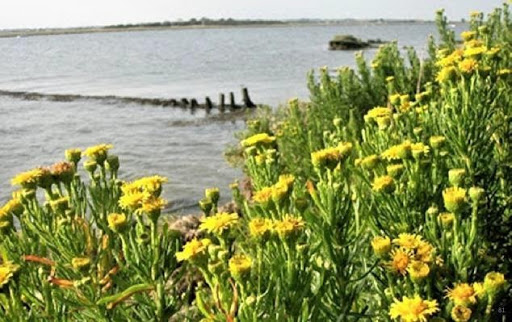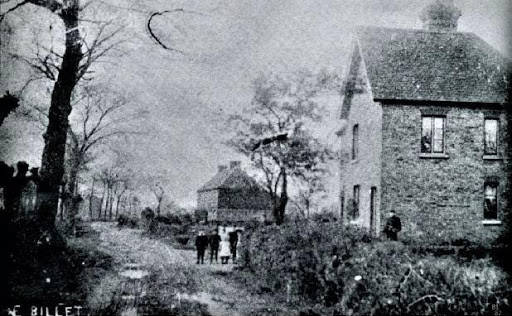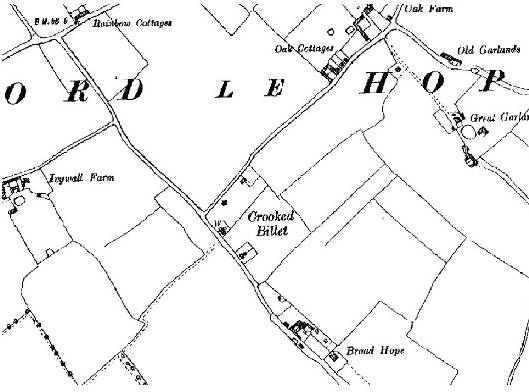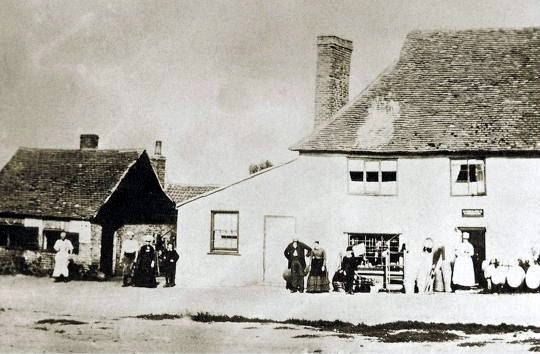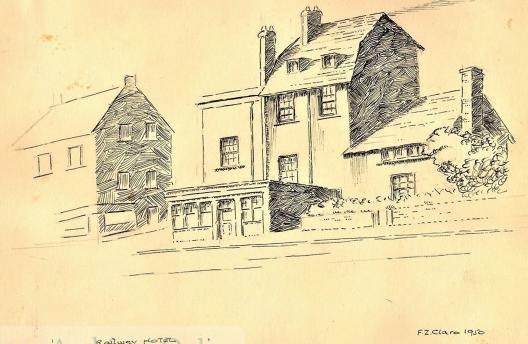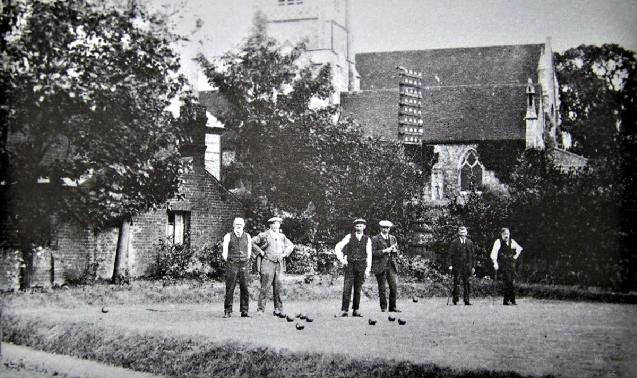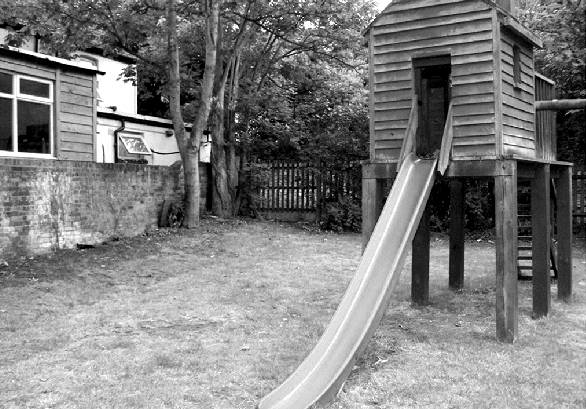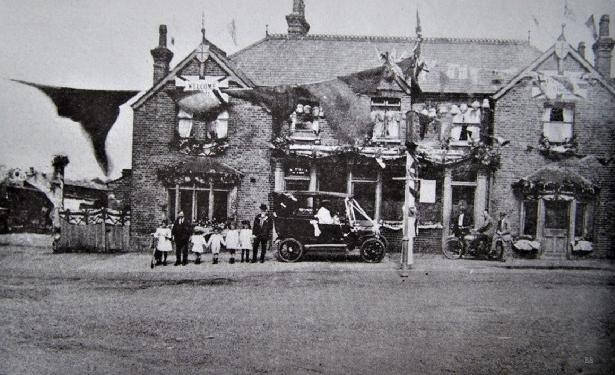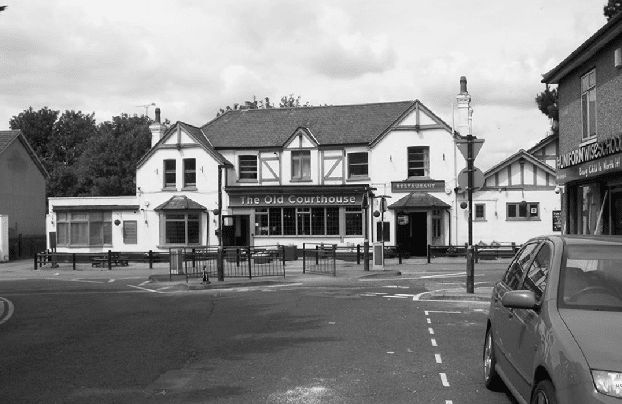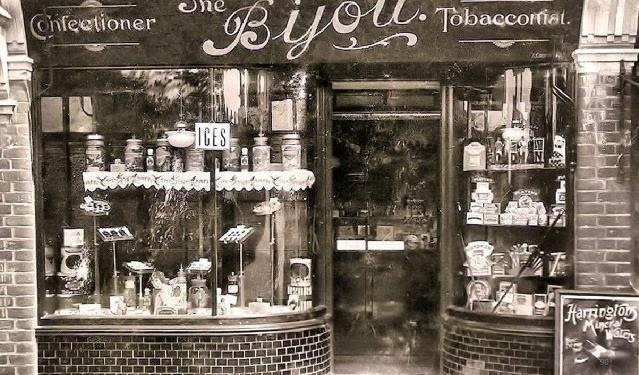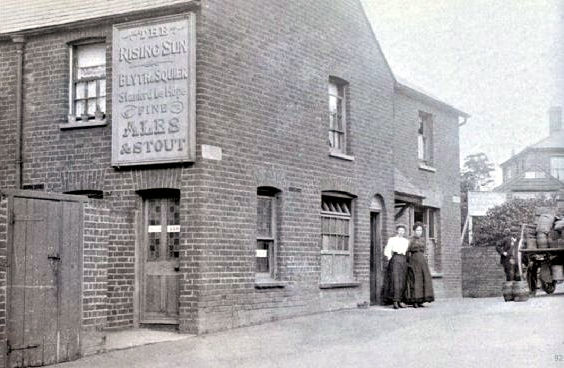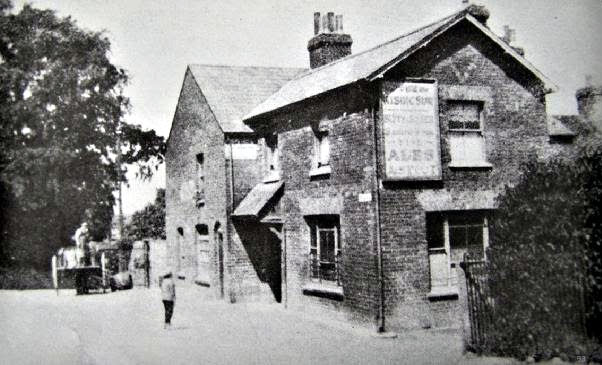Public Houses and Inns
The public houses and inns are amongst the oldest buildings in the area, even the newest of them, the Rising Sun, dates from circa 1867.
The brewing of ale was commonplace in some of the larger houses prior to the late 19th century, for example an 1853 Beadel and Chancellors sales prospectus details says this about Pitsey’s farm house. “a very convenient residence, which has recently undergone a through reparation, containing two parlours, kitchen, brew house, beer cellar, pantry, dairy, and five bedrooms”
Location of Pitsey’s and Grubbs Farms from an 1853 Beadel and Chancellors sales prospectus. At the time of the 1840 tithe map Pitsey’s farm had been known as Pease farm
The Crooked Billet
The Crooked Billet ale house, which was appended to Fobbing manor, was located near the corner of Rainbow Lane and High Road and dated from at least 1713 and was probably very much older. In 1741 fire insurance policy records state that the house was made of timber and tile, in the occupation of Thomas Merris victualler, who was insured for £150.
It was used by drovers as lodgings after they had travelled long distances with their cattle or sheep. As early as the 14th century sheep were valued for their milk from which a delicate and nutritious cheese could be made. The drovers lodging at the ale house would graze their sheep on Curry marsh where a variety of grass which was particularly suitable for the sheep known as samphire, grew in abundance.
Golden Samphire
The cheese was formed into 225 pound hoop shaped segments known as weys. These cheeses were in great demand on the continent and were shipped from Fobbing wharf. They were also sent to London from what was known as the long ferry from East Tilbury. The old Inn was demolished in the latter part of Queen Victoria’s reign. A row of farm cottages called Billet Cottages and Billet Lane are named for the old Ale House.
Billet in this context is an old word for a stick or branch and so a crooked billet means a bent stick, branch or wooden beam. This could refer to a structural beam within the building or a bent stick forming the old ale house sign which would likely have been placed above the doorway. It was also a term used for a bat in the many bat and ball games dating back to Saxon times which may have been the earliest precursors of the modern game of cricket, the old Saxon word for a wooden staff being cric. For these reasons The Crooked Billet is a fairly common pub name.
Location of Billet cottages still noted as Crooked Billet from a 1924 map. By this time Grubbs and Pitseys farms were renamed as Oak farm
The Cock and Magpie
The Cock and Magpie which was mentioned earlier in connection with Edward Wootten, was probably the oldest public house in the village and was likely to have been over 400 years old when it was converted into a general store in 1860. Its former bar parlour was later used as an ironmonger’s shop by Samuel Cowell, the village blacksmith.
The Cock and Magpie was a favourite haunt of the Thames bargemen who anchored at Stanford Wharf. By the time they had walked the length of Wharf Road to reach it they were probably in need of a drink especially on a hot day.
By the 1920’s the building was derelict and a plan was mooted to use the site as the location of offices and meeting rooms for the parish council, which did not have a permanent home and had to meet in the bank chambers or the local school. This scheme did not go ahead however and the pub was not demolished until 1929. Whilst undergoing demolition the workmen found Georgian coins and soldiers’ brass buttons under the floorboards but what happened to these items is unknown.
The former site of the Cock and Magpie is now occupied by the Lloyds Bank building.
The Railway Hotel from a Pen and Ink Sketch by F Z Claro in 1950
There are relatively few accounts of the history of Stanford compared with other towns and villages in the former Orsett Union and later Urban District of Thurrock. What accounts there are, state that the inn that we know today as the Railway Tavern was the original Kings Head and gave its name to King Street. The original building is certainly old dating from at least 1550 and was constructed from wattle and daub. If it was an ale house it was probably originally a private dwelling whose owners began brewing their own ale and selling it from their parlour in what were known as ale houses or tippling houses. A well still exists in the position of the current saloon bar which would have originally been in the rear garden of the house.
The existing accounts simply state that this pub changed its name from The Kings Head to The Railway Hotel in 1854 when the London Tilbury and Southend Railway reached Stanford and a new Kings Head, the building we know today as The Old Courthouse, was built circa 1860. The problem with this account is that the 1839 tithe map of the area quite clearly shows the Kings Head in the approximate location of today’s Old Courthouse.
An alternative account is that the original Kings Head was located slightly east of today’s Old Courthouse just about where a block of flats was erected in 2016. This would have been a market inn that would have sold horses, pigs, fowl, and rabbits at the land to its rear. This inn was demolished and replaced by the new building in 1860. The new building retained the market licence for some years which enabled it to open at four in the morning. This account would be in agreement with the 1839 map.
Wherever it was located, witches were said to have been hanged at the rear of the original Kings Head although the only witch trial in the official record for Stanford le Hope was that of Catherine Hooke in 1638 who was sent for trial at Chelmsford but acquitted. The Witchcraft Act of 1735 made it an offence to accuse any person of practising witchcraft or of possessing magical power and bought an official end to the witch trials, however anecdotal evidence suggests that the last witch to be hanged in Stanford was in 1776 and that in some small villages supposed witches were still being burned or hanged until 1790.
For many years the coroners court met at the inn and inquests were held on cases of murder; suicide and also on human remains or bones that were sometimes washed up by the tide at the wharf. The most notable inquest to be held there was that into the death of William Malcolm a Barking fisherman who had been shot for trespass on the sea wall at Shell Farm in March 1830 by a Captain Moir formerly of the Indian army who had taken up residence at the farm. Malcolm who had been shot in the arm had not died immediately but by tetanus that had set in the wound in spite of attention from the Stanford physician at the time Dr.Dodd.
The coroner’s jury was assembled from local villagers and included Dr.Dodd who resided at the doctor’s house now the Inn in the Green. After a hearing of six hours the jury returned a verdict of wilful murder and Moir was committed for trial at Chelmsford. The case was heard by Lord Tenterden on 30th July and a verdict of capital murder was returned. Moir who was by all accounts a fine gentleman if a little hot headed, had many well connected friends who made strenuous efforts to save him from the gallows but to no avail and Moir was hanged on 2nd August 1830. He was just 36 and his wife a mere 28 and they had three young children.
As we have noted the Railway Hotel was certainly in being after 1854, and the outer Victorian building was added to the building at this time along with the stables and public toilets to the side. There were several letting rooms upstairs also constructed at this time where travellers on the late trains would have spent the night before continuing their journey next day by pony and trap.
In 1860 when the Cock and Magpie was converted to a general store, The Railway Hotel took over its licence enabling it to sell wines and spirits.
In the cellar is brick wall that reputedly covers the entrance to a tunnel running to the original Kings Head and also a metal cover which again is said to cover the access to another former tunnel supposed to have run to the Hassing Brook and formerly used by smugglers but such a tunnel would have been hazardous to construct and use due to the saturated ground and the threat of flooding. Also no evidence of such a tunnel has ever been recorded as a result of subsequent building or utility works in the vicinity. Set against that is the fact that smuggling was known to have taken place on a considerable scale and a field by the name of Watch House Piece once existed at the junction of Victoria Road and London Road at the site of the existing Welcome Club and it seems very likely that a watch house was established at this location to keep a check on the activity by the stream.
Messrs Offin and Rumsey the well known auctioneers who founded the Stanford Cattle Market held many of their auctions in the upstairs function room.
There is anecdotal evidence to suggest that an inn called the Hoop and Grapes existed for a time in the village and it is possible that this was the original name of the Railway Hotel.
To the rear of the Railway Hotel was one of the finest bowling greens in Essex complete with a gate leading to the Rising Sun.
The new 1860 Kings Head was enlarged in the early 1920s with the addition of a small function room to the left flank wall as viewed from King Street and a later larger room on the right flank that is now used as a restaurant.
The Rising Sun
In 1865 John Blyth a farmer of Hassingbrook Hall, borrowed £200 from his brother Thomas to purchase the land behind the Railway Hotel which was in the gift of Abbots Hall Manor together with cottages built by a Richard Grover that were already on the plot. An 1867 street map shows a steep bank on the south side of Church Hill where the footpath now is and it is possible that a retaining wall was constructed at around this time and the spoil that was dug out was used to level the ground for the bowling green as it would otherwise have sloped to the rear of the Railway Hotel.
John Blyth also established the Stanford-le-Hope brewery which stood in London Road on the village side of the Hope River or Hassing Brook and it appears that he may have converted the cottages on the plot of land he purchased into an ale house that he called the Rising Sun. There was originally a spiral staircase from the public bar to a function room where boxing matches were held.
John Blyth died in 1877 and in 1878 his widow Ann leased the Rising Sun; the Stanford brewery and another ale house on Canvey called the Red Cow to Samuel Westwood Squier for 21 years for three hundred pounds a year. The Brewery was afterwards listed as belonging to Blyth and Squier. After the 1953 floods the Red Cow on Canvey was renamed the King Canute.
The King Canute is no longer in existence having been replaced by a residential development.
The Inn on the Green
The Inn on the Green was the original village doctor’s house. It is over four hundred years old and listed Grade 2 by Historic England. Being a listed building means that it still retains the old stables and hay loft to the rear. It was converted to a public house that opened in 1978.
